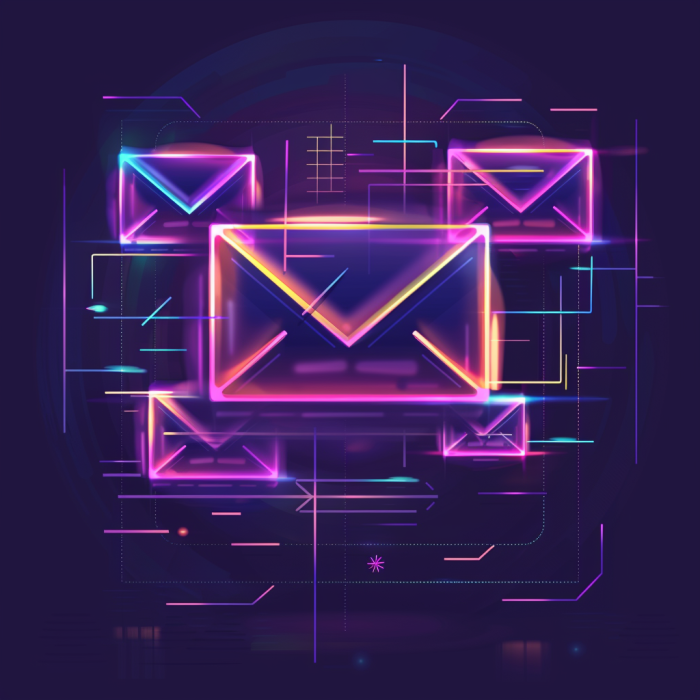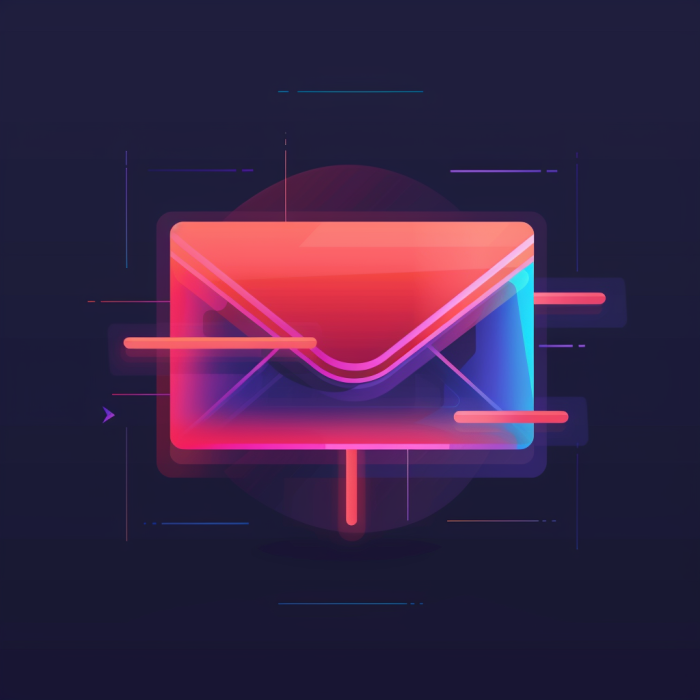The Ultimate Guide to Dark Mode Email Optimization
What is Dark Mode in Emails?
In the ever-evolving landscape of digital communication, email marketers are continuously adapting to the preferences and needs of their audience. One such adaptation is the integration of dark mode in emails, a feature that has rapidly gained popularity for its aesthetic appeal and user-centric benefits. Let's dive into what dark mode is, its advantages, and its impact on email design and deliverability.
Understanding the Concept of Dark Mode
Imagine turning the lights off in a room to enjoy a movie; that's essentially what dark mode does for your digital screens. It reverses the color scheme of your emails, using light-colored text, icons, and UI elements on a dark background. This mode not only reduces eye strain in low-light conditions but also extends battery life for devices with OLED or AMOLED screens. For email marketers, adapting to this preference means rethinking design strategies to ensure content is accessible and appealing in both light and dark environments.
Key Takeaway: Dark mode inverts traditional color schemes to improve readability and reduce eye strain, offering a user-friendly viewing experience.
Benefits of Implementing Dark Mode in Email Design
Incorporating dark mode into your email design brings several benefits. Firstly, it caters to user preference, allowing subscribers to engage with your content in their chosen viewing mode. This alignment with user needs can enhance the overall user experience, potentially increasing engagement rates. Furthermore, dark mode can give your emails a modern, sleek appearance, helping your brand stand out. By designing for both light and dark modes, you ensure that your message retains its intended impact, regardless of the user's settings.
Key Takeaway: Adapting your email designs for dark mode enhances user experience, supports brand positioning, and ensures content consistency across viewing preferences.
Impact of Dark Mode on Email Deliverability
While dark mode primarily affects the visual aspect of your emails, it can indirectly influence email deliverability. Emails optimized for dark mode signal to recipients and email service providers that you're keeping up with technological trends and prioritizing user experience. This can improve your sender reputation, as it shows a commitment to quality and relevance. However, it's crucial to properly code and test your emails for dark mode to avoid rendering issues that could negatively affect deliverability.
Key Takeaway: Properly optimized emails for dark mode can bolster your sender reputation and indirectly positively impact deliverability by showcasing your commitment to user experience.
How to Optimize Your Emails for Dark Mode?
As the digital world evolves, so do the preferences of its users, with dark mode being one of the most significant shifts in recent times. For email marketers, this shift means adapting strategies to ensure emails shine in every inbox setting. Dark mode not only offers a visually striking alternative to the traditional light background but also promises an improved user experience. Let's explore how to fine-tune your emails for dark mode, ensuring they remain effective and engaging regardless of user settings.
Design Best Practices for Dark Mode Email Templates
Think of transitioning your email design to dark mode as preparing for a night event; you'd want your invitations to be visible and inviting in dim light. Start by choosing colors that adapt well to both light and dark backgrounds, ensuring legibility and aesthetic appeal. Utilize transparent PNGs for images to seamlessly blend with any background. Embrace a flexible design that looks impeccable in both settings, maintaining brand consistency and enhancing user experience.
Key Takeaway: Adaptable color schemes and flexible designs ensure your emails are accessible and visually appealing in both dark and light mode.
Using CSS to Ensure Proper Dark Mode Styling
In the tapestry of web design, CSS is your thread of choice for weaving through different style scenarios, including dark mode. Use CSS media queries to detect if a user has enabled dark mode and adjust your email’s styles accordingly. This can include changing background colors, text colors, and even image assets to ensure optimal readability and visual integrity in dark mode. Remember, the goal is to create a seamless transition between modes without losing the essence of your email’s design.
Key Takeaway: CSS media queries are instrumental in automatically adapting your emails to dark mode, preserving readability and design integrity.
Testing Your Emails in Different Dark Mode Settings
Just as a chef tastes their dishes before serving, testing your emails across various clients and modes is crucial. Not all email clients render dark mode in the same way, so it’s important to test your emails in environments like Outlook, Gmail, and Apple Mail in both light and dark settings. This ensures your message delivers the intended experience, regardless of how subscribers choose to view it.
Key Takeaway: Comprehensive testing across different clients and modes guarantees your emails perform as intended, offering a consistent user experience.
Fun Fact
Did you know that the concept of dark mode was originally developed to conserve energy on CRT screens and to reduce eye strain? Today, it’s a popular aesthetic choice for digital interfaces, reflecting how user preferences and technology evolve together.
Which Email Clients Support Dark Mode?
With the rising popularity of dark mode among digital users, email marketers are increasingly focusing on how to adapt their campaigns to meet this preference. Dark mode not only offers a user-friendly alternative to the traditional bright screens but also presents unique opportunities and challenges in email design and deliverability. Understanding which email clients support dark mode and how to optimize for them is crucial for ensuring your messages resonate with your audience.
Overview of Email Clients that Enable Dark Mode
Just as every painter needs to know their canvas, every email marketer needs to understand the platforms their audience uses. Major email clients such as Apple Mail, Outlook, and Gmail now offer dark mode settings, each with its nuances in implementation. For instance, Apple Mail provides a comprehensive dark mode experience, affecting both the email interface and email content. Gmail and Outlook also support dark mode, with Gmail allowing users to switch manually and automatically based on their system settings. Knowing these details helps in tailoring your emails to look their best across all platforms.
Key Takeaway: Familiarize yourself with how major email clients implement dark mode to ensure your emails are displayed as intended, enhancing user experience and engagement.
Optimizing Emails for Specific Dark Mode Settings in Various Clients
Optimizing your emails for dark mode involves more than flipping a switch; it's akin to translating your message into a different language, considering the specific settings and preferences of each email client. Utilize CSS media queries to detect if dark mode is enabled and adjust your email's styles accordingly. Consider the contrast and legibility of text, the visibility of images, and the overall aesthetic to ensure your message remains clear and engaging. Remember, the goal is to maintain the integrity and effectiveness of your email campaign, whether viewed in light or dark mode.
Key Takeaway: Employ CSS media queries and thoughtful design principles to ensure your emails are optimized for dark mode, maintaining legibility and visual appeal across various email clients.
Common Challenges in Implementing Dark Mode
As the night sky brings a sense of calm, so does dark mode in the digital environment, offering a visually soothing alternative to the bright, light-filled screens. However, for email marketers venturing into this less illuminated world, several challenges await. Adapting your email campaigns for dark mode is like preparing for a night hike; you need the right tools and knowledge to navigate successfully. Let's shed some light on the common hurdles and how to overcome them.
Addressing Issues with Dark Text on Dark Background
Imagine reading a book in the dark with only faint moonlight; that's how recipients feel when encountering dark text on a dark background in emails. This common issue arises when email clients automatically invert colors for dark mode, leading to readability problems. To counteract this, use CSS to define specific styles for dark mode, ensuring text appears in lighter shades against the darker backdrop, maintaining legibility and ensuring your message is clearly conveyed.
Key Takeaway: Implement CSS solutions to prevent dark text on dark backgrounds, ensuring your emails remain readable in dark mode.
Ensuring Accessibility in Dark Mode Email Design
Navigating through a darkened room requires caution to avoid obstacles; similarly, designing emails for dark mode requires a mindful approach to accessibility. Contrast is key; ensure there is sufficient contrast between text and background to aid those with visual impairments. Also, consider using larger fonts and clear, sans-serif typography to enhance readability. Remember, the goal is to create an inclusive design that caters to all subscribers, regardless of their mode preference or visual capabilities.
Key Takeaway: Focus on contrast and readability to make dark mode emails accessible to everyone, enhancing the user experience for your entire audience.
Strategies for Switching Between Light and Dark Mode Settings
Transitioning smoothly between light and dark modes is like adjusting your eyes from daylight to dusk; it should be seamless and natural. To achieve this in your emails, utilize CSS media queries that detect the user's preference and automatically adjust the email's appearance accordingly. Consider creating dual versions of images and icons that can work well in both settings, ensuring your visual elements are always clear and engaging. Testing across various email clients will help you refine these transitions, ensuring your emails look their best in any light.
Key Takeaway: Use CSS media queries and dual-versioned images to seamlessly transition your emails between light and dark modes, catering to user preferences effectively.
FAQs
Q: How do I ensure my email looks good in both light and dark mode?
A: Design with flexibility in mind, using CSS for adaptable text and background colors, and test across different email clients to ensure compatibility.
Q: Can all email clients automatically switch between light and dark mode?
A: Not all email clients support automatic switching. Focus on designing emails that render well in both modes regardless of automatic detection.
Q: Will using dark mode in my emails improve deliverability?
A: Dark mode itself doesn’t directly impact deliverability, but well-designed, accessible emails that engage readers can positively influence your sender reputation.
Q: Is it more difficult to design emails for dark mode?
A: Designing for dark mode requires consideration of contrast, color schemes, and testing but isn’t necessarily more difficult—just different. With the right tools and strategies, you can create stunning emails for any mode.
Inagiffy: Your Ultimate Newsletter Marketing Partner
In today's crowded digital landscape, building genuine, lasting connections with your audience is more crucial than ever.
Enter Inagiffy – a premier newsletter marketing agency that understands the transformative power of well-crafted newsletters. We're not just about sending out emails; we're about curating stories, insights, and value that resonate deeply with your audience.
Our end-to-end solutions ensure that from ideation to delivery, every newsletter reflects your brand's essence and speaks directly to your audience's needs and aspirations. Let Inagiffy empower your brand, forging authentic relationships and driving engagement through the potent medium of newsletters.
Dive into the future of meaningful communication with us and watch your audience grow, engage, and thrive.


Comments
Your comment has been submitted successfully!